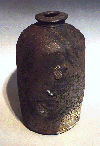Anagama
 The Anagama kiln is the oldest
style of kiln in Japan and has been around since medieval times. The
beauty of Anagama style firing
lies in the natural ash glazes that can be achieved, and in the excitement of
the long firing itself, appreciated by many potters all over the world.
The Anagama kiln is the oldest
style of kiln in Japan and has been around since medieval times. The
beauty of Anagama style firing
lies in the natural ash glazes that can be achieved, and in the excitement of
the long firing itself, appreciated by many potters all over the world.
There are many different designs for the Anagama kiln, not only in Japan,
but on other continents. Not only are there different designs, but also different
methods of firing and stacking.
No two firings are ever exactly alike, in contrast to let's say, the electric
kiln.
The Anagama kiln will usually consist of of one long firing chamber with a
firebox at one end and a flue at the other. Often there will also be smaller
stacking ports on the side of the kiln. Traditional Anagama kilns are built
on a slope, so that a better updraught can be achieved. Firing time can vary
from one day to several weeks.
While Anagama is an ancient Japanese style, contemporary ceramic artists such
as Peter Voulkos
(USA), Chester
Nealie (Australia), Dick Lehman
(USA), Uwe Loellmann or Shiho
Kanzaki (Japan) and many other have taken up the art and are continuing
the tradition.
More Articles
 The Anagama kiln is the oldest
style of kiln in Japan and has been around since medieval times. The
beauty of Anagama style firing
lies in the natural ash glazes that can be achieved, and in the excitement of
the long firing itself, appreciated by many potters all over the world.
The Anagama kiln is the oldest
style of kiln in Japan and has been around since medieval times. The
beauty of Anagama style firing
lies in the natural ash glazes that can be achieved, and in the excitement of
the long firing itself, appreciated by many potters all over the world.